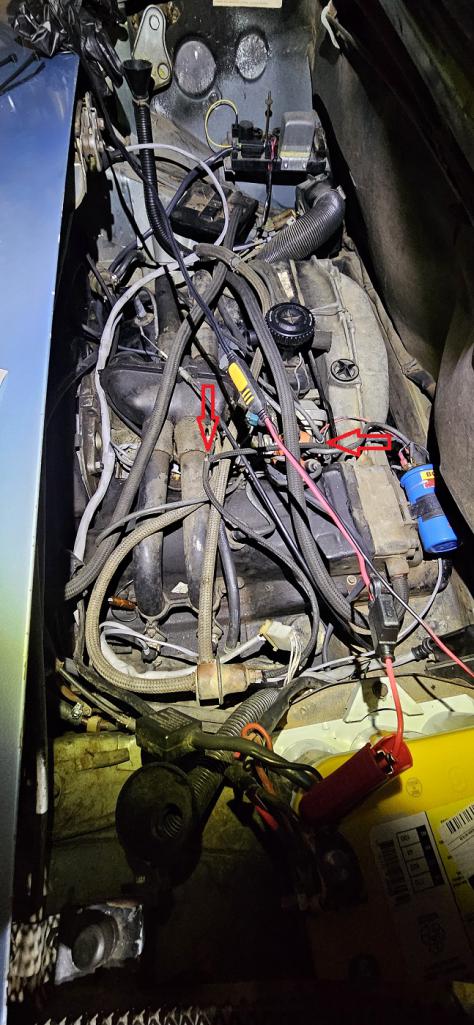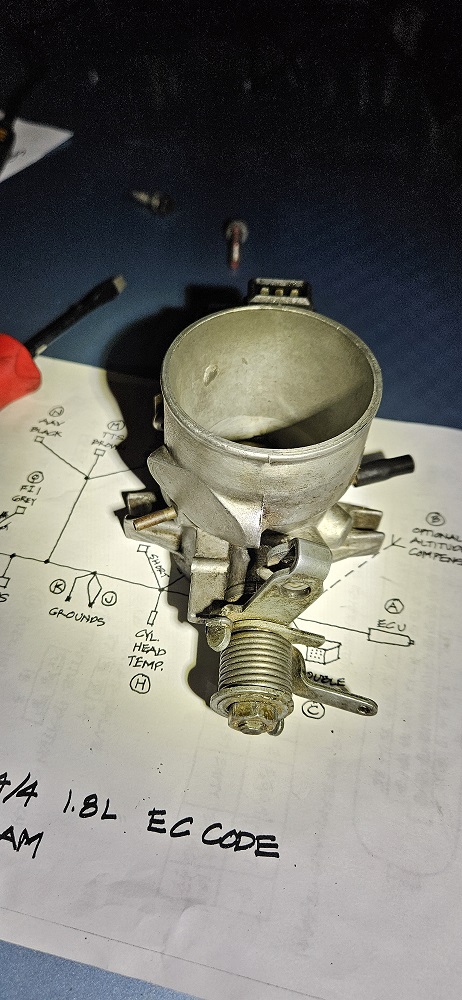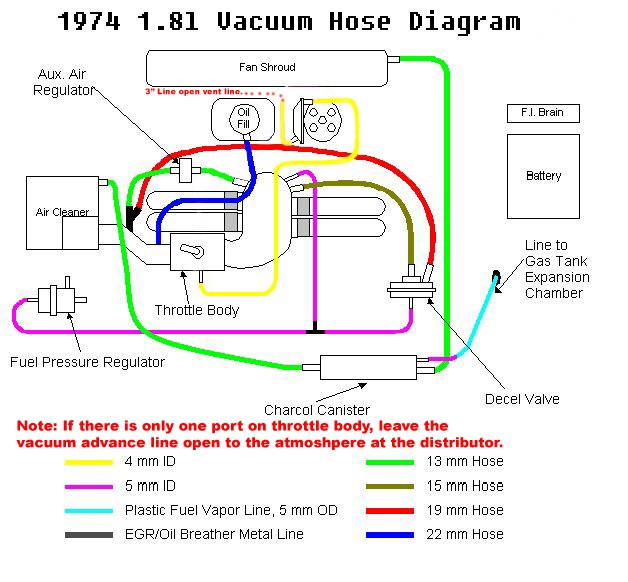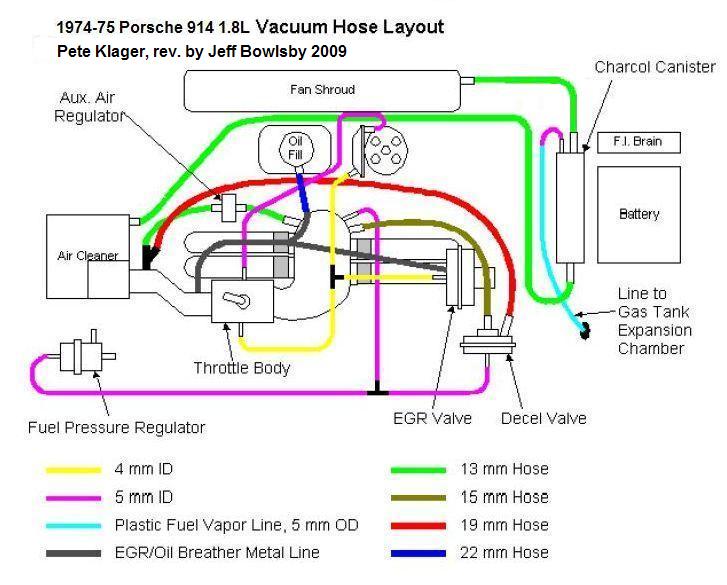|
|

|
Porsche, and the Porsche crest are registered trademarks of Dr. Ing. h.c. F. Porsche AG.
This site is not affiliated with Porsche in any way. Its only purpose is to provide an online forum for car enthusiasts. All other trademarks are property of their respective owners. |
|
|
| L-Jet914 |
 Feb 25 2025, 11:35 PM Feb 25 2025, 11:35 PM
Post
#1
|
|
Member   Group: Members Posts: 365 Joined: 24-October 12 From: Davis, CA Member No.: 15,080 Region Association: Northern California |
I was installing my new ignition and FI harnesses today and I decided to look back at the vacuum hose routing diagram on Jeff Bowlsby's website. I knew my vacuum hose routing had been modified by whatever technician worked on my father's 74 914 1.8 years ago. I noticed that they teed the vacuum retard side of the vacuum advance into ported vacuum off of the intake plenum. According to the vacuum routing hose diagram, it's supposed to be connected to the rear port of the throttle body (which only gets vacuum after the throttle plate moves off idle). Would there be any reason the technician did this? I will end up rerouting the vacuum hose to the proper location. I'm just curious as to why it was modified for whatever reason. So would my 74 1.8 be considered a early or late 1.8? According to the late diagram and the throttle body that is in the car, the hose should route to the front port instead of the rear port.
The part number on the throttle body in the car 022133067C which fits either a Super Beetle 75-79, 76-83 Bus, or 83-84 Vanagon (two port t-body). According to the PET on AA's website shows two different throttle bodies 022133062L or 022133062S for California spec 1.8L 914s. The Porsche PET does not list a throttle body part number for the 1.8, only the 1.7 and 2.0s. Curious as to why someone would put the wrong part number throttle body on my 914, though it does have the 3 pin throttle position sensor. Port setup would be indicative of late 74 because the required port (front of throttle body pointing toward front of vehicle) is behind the throttle plate. Attached thumbnail(s)  Attached image(s)   
|
  |
Replies
| wonkipop |
 Feb 26 2025, 02:29 PM Feb 26 2025, 02:29 PM
Post
#2
|
|
914 Guru      Group: Members Posts: 5,191 Joined: 6-May 20 From: north antarctica Member No.: 24,231 Region Association: NineFourteenerVille 
|
@L-Jet914
if you think i have mixed up the letter codes on the engines from 74 to 75 i haven't. for quite a while the codes confused both jeff bowlsby and i. we thought they ought to follow the logic of an A or a would indicate california and a B or b would indicate 49 states. but thats not the logic they used. then i realised why one day. an EC-A california 74 becomes an EC-b california 75. and the EC-B 74 49 states becomes EC-a 75 49 states. and the reason is simple. an EC-A is essentially the same as an EC-a in terms of design. despite the first being the california compliant design in 74 and the 49 states in 75. the germans did their coding on pure engine design rather than leaving the code to indicate which state year to year. design stayed pretty much the same as was called the A or the a. where it complied changed. same goes for the EC-B and the EC-b from 74 to 75. its essentially the same design except they substitute in an EGR in place of vac timing advance. but they activate the EGR the same way they activated vac advance. you got to think like a german to understand how they were naming things. (IMG:style_emoticons/default/biggrin.gif) (IMG:style_emoticons/default/biggrin.gif) |
Posts in this topic
 L-Jet914 vacuum hose routing question Feb 25 2025, 11:35 PM
L-Jet914 vacuum hose routing question Feb 25 2025, 11:35 PM
 wonkipop the authorative hose diagrams are here mate. bott... Feb 26 2025, 04:37 AM
wonkipop the authorative hose diagrams are here mate. bott... Feb 26 2025, 04:37 AM

 L-Jet914
the authorative hose diagrams are here mate. bot... Feb 27 2025, 10:21 PM
L-Jet914
the authorative hose diagrams are here mate. bot... Feb 27 2025, 10:21 PM
 JeffBowlsby Michael is the L-Jet MAN. That diagram on my site... Feb 26 2025, 09:09 AM
JeffBowlsby Michael is the L-Jet MAN. That diagram on my site... Feb 26 2025, 09:09 AM

 StarBear
Michael is the L-Jet MAN. That diagram on my sit... Feb 26 2025, 02:04 PM
StarBear
Michael is the L-Jet MAN. That diagram on my sit... Feb 26 2025, 02:04 PM

 wonkipop
Michael is the L-Jet MAN. That diagram on my si... Feb 26 2025, 02:39 PM
wonkipop
Michael is the L-Jet MAN. That diagram on my si... Feb 26 2025, 02:39 PM
 wonkipop @L-Jet914
i looked up the PET i have on file and... Feb 26 2025, 02:12 PM
wonkipop @L-Jet914
i looked up the PET i have on file and... Feb 26 2025, 02:12 PM
 wonkipop for your interest @L-Jet914 .
here is an image ... Feb 26 2025, 03:52 PM
wonkipop for your interest @L-Jet914 .
here is an image ... Feb 26 2025, 03:52 PM
 Fazasport I have a 1976 914 2.0 with D-Jet and no modificati... Feb 27 2025, 06:17 AM
Fazasport I have a 1976 914 2.0 with D-Jet and no modificati... Feb 27 2025, 06:17 AM

 wonkipop
I have a 1976 914 2.0 with D-Jet and no modificat... Feb 27 2025, 06:21 PM
wonkipop
I have a 1976 914 2.0 with D-Jet and no modificat... Feb 27 2025, 06:21 PM
 wonkipop @L-Jet914
david - that throttle body looks ident... Feb 28 2025, 10:57 AM
wonkipop @L-Jet914
david - that throttle body looks ident... Feb 28 2025, 10:57 AM

 L-Jet914
[b]@[url=http://www.914world.com/bbs2/index.php?s... Feb 28 2025, 07:57 PM
L-Jet914
[b]@[url=http://www.914world.com/bbs2/index.php?s... Feb 28 2025, 07:57 PM
 Rob-O Beyond all the hooking up of vacuum lines, the cha... Mar 3 2025, 07:35 AM
Rob-O Beyond all the hooking up of vacuum lines, the cha... Mar 3 2025, 07:35 AM

 wonkipop
Beyond all the hooking up of vacuum lines, the ch... Mar 3 2025, 05:53 PM
wonkipop
Beyond all the hooking up of vacuum lines, the ch... Mar 3 2025, 05:53 PM
 L-Jet914 Sorry for opening up a can of worms haha. When I r... Mar 4 2025, 12:35 AM
L-Jet914 Sorry for opening up a can of worms haha. When I r... Mar 4 2025, 12:35 AM

 emerygt350
Sorry for opening up a can of worms haha. When I ... Mar 4 2025, 08:39 AM
emerygt350
Sorry for opening up a can of worms haha. When I ... Mar 4 2025, 08:39 AM

 L-Jet914
Sorry for opening up a can of worms haha. When I... Mar 4 2025, 04:39 PM
L-Jet914
Sorry for opening up a can of worms haha. When I... Mar 4 2025, 04:39 PM

 wonkipop
Sorry for opening up a can of worms haha. When I... Mar 5 2025, 04:34 AM
wonkipop
Sorry for opening up a can of worms haha. When I... Mar 5 2025, 04:34 AM

 L-Jet914
Sorry for opening up a can of worms haha. When I... Mar 9 2025, 11:16 PM
L-Jet914
Sorry for opening up a can of worms haha. When I... Mar 9 2025, 11:16 PM
 emerygt350 Maybe my next CAD project. Mar 4 2025, 05:47 PM
emerygt350 Maybe my next CAD project. Mar 4 2025, 05:47 PM

 L-Jet914
Maybe my next CAD project.
Oooo. That would be a... Mar 4 2025, 05:54 PM
L-Jet914
Maybe my next CAD project.
Oooo. That would be a... Mar 4 2025, 05:54 PM
 emerygt350 I think I might have to try this project. Mar 4 2025, 07:25 PM
emerygt350 I think I might have to try this project. Mar 4 2025, 07:25 PM
 emerygt350 Yes, there is definitely that "driving a lazy... Mar 5 2025, 05:25 AM
emerygt350 Yes, there is definitely that "driving a lazy... Mar 5 2025, 05:25 AM  |
1 User(s) are reading this topic (1 Guests and 0 Anonymous Users)
0 Members:

|
Lo-Fi Version | Time is now: 2nd November 2025 - 01:15 PM |
Invision Power Board
v9.1.4 © 2025 IPS, Inc.







